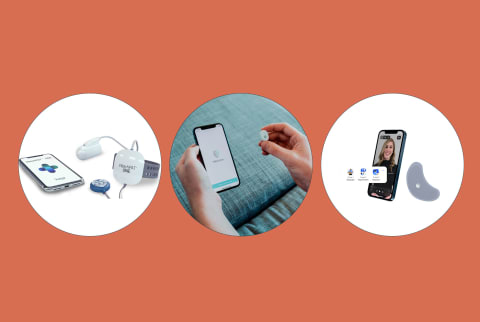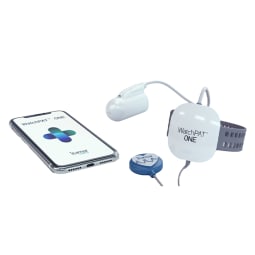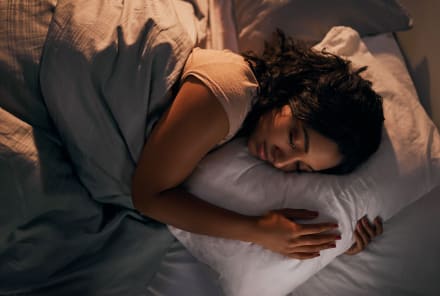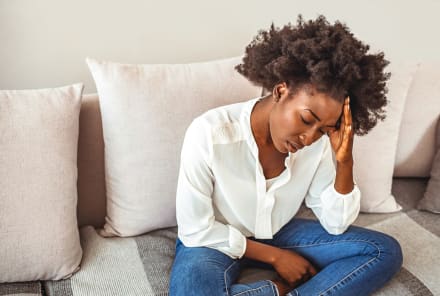Advertisement
The Best At-Home Sleep Apnea Tests Of 2023 + Factors That Impact Sleep Apnea



The best at-home sleep apnea tests
We all know quality sleep is crucial for our overall health—yet there still seem to be a multitude of obstacles that stand in its way. One serious barrier to restorative sleep is obstructive sleep apnea (OSA), a condition that causes you to stop breathing for intervals of time during sleep. The best at-home sleep apnea tests give insight into your sleep quality so you can do your best to optimize it.
OSA occurs when the muscles that support the tissues in your throat relax and cut off airflow. The condition can lead to symptoms such as snoring and daytime drowsiness and even cognitive decline or cardiovascular disease.
Experts estimate one in five people1 experience mild symptoms of sleep apnea, while one in 15 have moderate to severe symptoms. If you're experiencing symptoms or concerns, it's always best to consult with a doctor.
In-lab sleep studies can cost well over $1,0002, but new in-home technology lets you test the quality of your sleep from the comfort of your own bedroom. However, like all at-home tests, DIY sleep studies have their pros and cons.
How do at-home sleep apnea tests work?
If you're hoping to test for obstructive sleep apnea at home, you can either have your doctor prescribe a test or schedule a telehealth consultation with a physician (more on this for each device below).
Once a physician determines you're a candidate for an at-home OSA test, you'll be able to order a device online. Upon receiving the device, you can test at your convenience.
According to Seema Bonney, M.D., founder and director of the Anti-Aging & Longevity Center of Philadelphia, the main purpose of an at-home sleep apnea test is to determine if the sleeper is having trouble breathing.
"[An at-home test] uses a simplified breathing monitor that tracks oxygen levels and effort of breathing," she explains. "It should check for at least oxygenation, movement of the torso (which is used to assess breathing), movement of the body (actigraphy), peripheral arterial tone (which measures respiratory events, or disordered breathing), and nasal pressure."
While specifics vary slightly from test to test, the general idea is that you'll use the provided sensors on your wrist, finger, or chest (ideally all three) to measure your breathing and heart rate throughout the night.
Once you stop the device the next morning, results will be sent to you or your physician. From there, you'll need to speak with your doctor about the test's findings and to discuss potential next steps.
Are at-home sleep apnea tests accurate?
While at-home sleep apnea tests can provide preliminary insights for your doctor, Bonney warns that they're not necessarily as accurate as in-lab tests, called polysomnography (or PSG).
"It's a good first step toward assessing obstructive sleep apnea, but at-home tests are not as thorough as an overnight sleep study done at a facility where there's a sleep tech and [the sensors] capture brain waves, muscle tone, and leg movements," she says.
Regardless of the device you choose, we suggest sharing your results with a doctor who can help determine whether the reading was accurate enough for an OSA diagnosis. From there, they'll be able to help you figure out a treatment plan.
The best at-home sleep apnea tests
Pros:
- Can be used over a longer period of time
- Doesn’t require a prescription
- Comprehensive daily insights
Cons:
- Not covered by insurance (but FSA eligible)
- Requires a monthly subscription
- Snoring detection requires your phone microphone
Measures:
Heart rateBlood oxygen levelSnoringSleep positionRespiratory effortSensors:
Chest and stomach patchesFinger pulse oximeterWesper is an at-home kit designed to be worn nightly, so you can track and share your sleep analytics with your doctor over an extended period of time. Whether you’ve already been diagnosed with OSA or are hoping to test for it, the kit collects data like your sleep position, heart rate, and blood oxygen levels.
Unlike the other picks below, Wesper is a monthly subscription, which means you can continue to use the device to track your sleep long term or mail it back to end your subscription.
The Wesper kit includes two FDA-approved patches, a finger pulse oximeter, a charging station, and replacement adhesives. Like the WatchPAT and NightOwl, you’ll need to download a companion app and use it to activate your device each night.
You’ll also need to activate your microphone, which is how the Wesper detects snoring—note that if you sleep with someone else who snores your data might get skewed.
The app will walk you through turning on and applying each of the two patches, as well as the finger pulse oximeter before you go to sleep. In the morning, you’ll end your session and receive your data in the app within minutes. You can use this data to communicate with your existing doctor, or schedule a consultation with one of Wesper’s designated physicians.
Pros:
- Helpful set-up video
- Disposable
Cons:
- Designed for only one reading
Measures:
Heart rateBlood oxygen levelActigraphyChest motionSnoringPeripheral arterial toneBody positionSensors:
WristFingerChestTelehealth consult price:
VariesItamar Medical’s WatchPAT One is an FDA-approved, user-friendly device that uses three contact points to measure baseline breathing metrics while you sleep. As the name suggests, the device includes a watch-style sensor, a chest sensor, and a finger sensor.
Your doctor can prescribe a WatchPAT, or you can order it online and fill out a set of medical assessment forms to be paired with a telehealth physician. Either way, you’ll need a code from a doctor to initiate the test.
When you’re ready to test, you’ll unbox the device and download an app to set it up. It might seem daunting, but the WatchPAT has a helpful set-up guide that will walk you through each step and there is a how-to video online if you’d like a little extra guidance.
Once you’ve applied the three sensors, all you need to do is start the test on your smartphone (which needs to be plugged in and within 15 feet away from you all night) and hit the hay. In the morning, you’ll stop the device via the app and your results will zip off to your designated physician who will review the results in a follow-up appointment.
Advertisement
Pros:
- Designed for multi-night testing
- May be more comfortable than WatchPAT
Cons:
- Only one sensor point
Measures:
Heart rateBlood oxygen levelActigraphySensors:
FingerTelehealth consult price:
$90 per visitAustralian-based NightOwl is the only other disposable at-home sleep apnea test on the market today. Unlike the WatchPAT pick above, this test is designed to be worn for three consecutive nights, which may help paint a more accurate picture of your sleep health.
With only a finger sensor and a smartphone app, the NightOwl may be a more comfortable fit for some. Of course, this single sensor needs to be applied correctly and stay on all night for an accurate reading.
Luckily, the device comes with thorough instructions and—in the case you get a bad reading—you can wear the NightOwl multiple times for new data.
Like WatchPAT, you’ll need a physician’s signoff to get started with a NightOwl device. Once you’ve submitted your test, you’ll receive an email (likely within three to five business days) when your results have been reviewed by a physician. From there, you may need to schedule a follow-up appointment to discuss next steps.
How we picked:
Accessibility
These at-home sleep apnea tests are designed to be accessible and more affordable than in-lab testing. Whether you already have a prescription from a doctor or need a telehealth visit with a physician, these companies can help you get an at-home test delivered (if prescribed).
Reviews
We read reviews on these at-home tests to ensure they are easy to navigate and able to help folks understand next steps toward managing sleep apnea.
Versatility
Not everyone will feel comfortable strapped into multiple devices. That's why we tried to include a few options that use various sensors so you can find the right device for your preferences.
Insurance
With the exception of Wesper, these at-home sleep apnea tests are likely covered by insurance (if deemed necessary by your doctor).
How to choose
When choosing which at-home sleep apnea test is best for you, it's important to consider the below factors:
Input from your doctor: With the exception of Wesper, you'll need a physician's signoff to take an at-home sleep apnea test. If you already have a doctor you visit, you may want to ask for their recommendation.
Insurance: If you're hoping to have the cost of your test covered by insurance, you'll want to opt for a WatchPAT or NightOwl test. However, actual coverage will vary by your specific insurance plan.
Sensors: If you're prone to claustrophobia, you may prefer a device with a smaller footprint. NightOwl only uses one sensor, while the other two devices on our list require readings from three points on your body.
Who should use a sleep apnea test at home?
Anyone who is concerned that they may have sleep apnea can speak with their doctor about taking a sleep apnea test at home. Typically, only those with moderate to severe OSA symptoms will be prescribed an at-home test.
"Indications for an at-home apnea test include disrupted sleep and daytime somnolence (drowsiness), as well as a partner reporting snoring or gasping while you're asleep," Bonney adds.
Additionally, there are some groups of people who are more likely to develop sleep apnea. Here are a few factors associated with OSA:
- Age: Both snoring frequency and the prevalence of sleep apnea tend to increase with age, up to 50 and 60 years old. However, researchers believe3 that this data may be less a result of actual age and more related to other age-related factors such as hypertension, obesity, or medications that cause sleep disturbances.
- Obesity: The majority of folks with OSA are clinically obese. Some research suggests4 that a combination of a low-calorie diet and regular use of a continuous positive airway pressure machine (CPAP) may help reduce symptoms of sleep apnea.
- Alcohol use: Findings from a 2018 review5 suggest that people who consume higher levels of alcohol have an increased risk (by 25%) of developing sleep apnea.
- Gender: As with snoring6, sleep apnea is more prevalent in males. Experts estimate a ratio of 2:1 (males to females with OSA) in the general population.
Who should not use an at-home sleep apnea test
These tests are designed specifically for sleep apnea, so if you're hoping to learn more about additional sleep disorders you're better off in a lab setting. Similarly, if you have a history of stroke, cardiorespiratory disease, or any medical condition that requires supervision, you'll want to opt for a lab test.
If you're not exhibiting symptoms of OSA and are simply curious about your sleep quality, you won't be prescribed a sleep apnea test. Wesper (above) doesn't require a prescription but still provides plenty of data. A wearable sleep tracker will also likely provide the insights you're after.
We should also note that, while they're designed to be user-friendly, these at-home devices do require a little tech savviness. Because the data is collected via Wi-Fi, you'll need to be able to download an app on a smartphone and follow along with guided prompts. If this is a complication, you may be better off in a lab setting.
Pros & cons of at-home sleep apnea tests
- Price: At-home tests are more affordable than lab tests, which typically cost over $1,000. Your insurance or flexible spending account (FSA) may also cover the cost of an at-home test.
- Ease: Going into a lab for a sleep study is a commitment. At-home tests allow you to learn more about the quality of your sleep from the comfort of your own bed. Plus, this environment sets you up for a sample that's more representative of your actual sleep (it's gotta feel a little strange sleeping in a lab!).
- Quick results: While lab tests can have long waiting lists and lengthy results timelines, most at-home test options can provide insights within days and can get you moving on to next steps more quickly. However, actual turnaround time varies by physician, so there's not one hard-and-fast timeline.
- Delaying the inevitable: While an at-home test can provide preliminary data you can share with your doctor, they may ask you to complete an in-lab sleep test anyway. This could be the case if you're diagnosed with sleep apnea and need to be fitted for a CPAP machine (although your doctor might prescribe one without a lab test).
- Accuracy: As with any at-home test, there's an increased likelihood of error. Without a lab technician present, there's no way to troubleshoot any problems that may arise during the night. And with fewer sensors than in-lab tests, there's a higher possibility that your results will be inaccurate or not paint the full picture.
- Fewer insights: Because these at-home tests only measure your breathing, oxygen levels, and heart rate, you may be missing out on more in-depth sleep activity data (such as your sleep stages). They also can't pick up on other sleep disorders, like narcolepsy.
- Requires a little tech savviness: These tests use smartphone apps, so they might not be accessible for folks who don't have access to technology or aren't as confident with it.
FAQ
How many hours of sleep do you need for a sleep apnea test?
The actual amount of sleep required for an accurate reading varies by test. While it's OK to get up during the night, most at-home tests require you to sleep for at least 2.5 hours to collect solid data.
Does anyone ever pass a sleep apnea test?
A "passed" sleep apnea test is possible, but the results may not always be accurate if you're testing at home. If you believe you present signs of sleep apnea but receive results that suggest otherwise, you'll likely want to consult with your doctor about an in-lab study.
Is there a way to self-diagnose sleep apnea?
While at-home tests will provide insights into whether or not you have obstructive sleep apnea, you’ll need to confirm the data with a board-certified physician who, if not involved from the beginning of your investigation, may require you to retest.
Additionally, CPAP machines require a prescription from your doctor—moral of the story: Keep your doctor in the loop!
How can I reverse sleep apnea naturally?
If you have mild sleep apnea (or are just a relentless snorer), there are a few methods you can try. Avoiding alcohol, working toward a healthy weight, and sleeping on your side are good places to start.
However, if you have severe sleep apnea, it's best to speak with your doctor, as OSA can lead to more serious health conditions.
The takeaway
Researchers estimate that one billion people7 globally have obstructive sleep apnea. If you find yourself waking up in the night gasping for air (or constantly getting whacked by your partner for snoring), you may want to consider an at-home sleep apnea test. Just make sure you're consulting with a physician to determine accuracy and next steps.
Still curious about your sleep quality? Our rest-obsessed team loves these sleep trackers.
Meet The Experts
7 Sources
- https://www.ncbi.nlm.nih.gov/pmc/articles/PMC3096276
- https://pubmed.ncbi.nlm.nih.gov/26118558/
- https://www.ncbi.nlm.nih.gov/pmc/articles/PMC9128480/
- https://www.ncbi.nlm.nih.gov/pmc/articles/PMC4138510/
- https://www.ncbi.nlm.nih.gov/pmc/articles/PMC5840512/
- https://pubmed.ncbi.nlm.nih.gov/2310278/
- https://www.ncbi.nlm.nih.gov/pmc/articles/PMC7007763/
Watch Next
Enjoy some of our favorite clips from classes
Enjoy some of our favorite clips from classes
What Is Meditation?
Mindfulness/Spirituality | Light Watkins
Box Breathing
Mindfulness/Spirituality | Gwen Dittmar
What Breathwork Can Address
Mindfulness/Spirituality | Gwen Dittmar
The 8 Limbs of Yoga - What is Asana?
Yoga | Caley Alyssa
Two Standing Postures to Open Up Tight Hips
Yoga | Caley Alyssa
How Plants Can Optimize Athletic Performance
Nutrition | Rich Roll
What to Eat Before a Workout
Nutrition | Rich Roll
How Ayurveda Helps Us Navigate Modern Life
Nutrition | Sahara Rose
Messages About Love & Relationships
Love & Relationships | Esther Perel
Love Languages
Love & Relationships | Esther Perel
What Is Meditation?
Box Breathing
What Breathwork Can Address
The 8 Limbs of Yoga - What is Asana?
Two Standing Postures to Open Up Tight Hips
How Plants Can Optimize Athletic Performance
What to Eat Before a Workout
How Ayurveda Helps Us Navigate Modern Life
Messages About Love & Relationships
Love Languages
Advertisement

New Study Confirms The 3 Habits That Age Your Brain Faster
Molly Knudsen, M.S., RDN



















